The Postcard Age
Selections from the Leonard A. Lauder Collection Celebrates the Postcard Craze that Revolutionized Communication at the Turn of the 20th Century
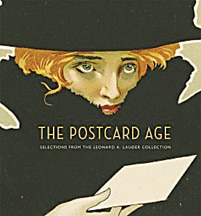
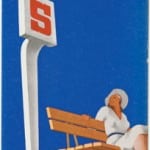
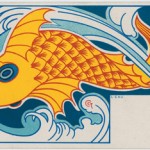

The Postcard Age takes visitors back in time to a tumultuous era in Europe and the Americas, when industrialization, urbanization, immigration, and shifting viewpoints about culture, class, women’s rights, and new money shook society. The dynamism of the era was embodied in the postcard mania, which reflected the obsession with novelty and the “need for speed,” while making inexpensive communication available to all.
“The postcards in the show just hint at the extraordinarily rich trove of stories and images in the Lauder Archive as a whole. Cards were so popular and so ubiquitous in these decades that nearly every fad, fashion, social concern, artistic style, or political event of the era found its place on a postcard. They are an artistic and historical resource without parallel—beautiful, fascinating, and fun all at once.” said Benjamin Weiss, the Leonard A. Lauder Curator of Visual Culture, who organized the exhibition with Lynda Klich, a Distinguished Lecturer, Art department, Hunter College, and Macaulay Honors College, City University of New York.
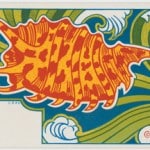
The exhibition showcases a wealth of beautiful and dramatic designs by well-known artists, such as Wassily Kandinsky and Alphonse Mucha, as well those less well known, and even still unidentified. They will be arranged thematically: Paris; The Craze; Style; About Town; Women; Famous and Familiar; Power, Speed, and Flight; Making the Sale; Healthy Bodies; Around the World; and The Great War.
In the late 19th century, Paris, the City of Lights, was a center of learning and culture and the epitome of all that was new and exciting. Universal Expositions, or world’s fairs, showcased a variety of modern marvels and entertaining attractions, such as the Eiffel Tower, which debuted in 1889, a tour de force of design that was then the tallest man-made structure. Crowds waited in line to ascend the tower where, in an upper-level room, visitors could write cartes postales to be mailed from the “Top of the Eiffel Tower.” The thousands who flocked to these fairs bought postcards to send loved ones back at home, writing “wish you were here” on cards such as The Great Wheel of the Exposition (about 1900) showing a Ferris wheel with the Eiffel Tower in the background.
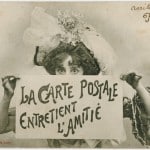
Artists and printers created beautiful works of art, many featuring the colorsaturated swirling lines and decorative patterns of art nouveau, which came into vogue during the period; other cards were embossed, used glitter, incorporated photographs, or were printed on silk, leather, or thin slices of wood. The exhibition includes numerous striking works, including the imaginative series The Elements (1898) by Belgian artist Gisbert Combaz.
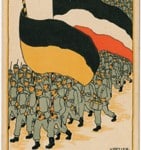
The evolving role of women in modern society also played out on the postcard, where they were portrayed as fashion icons, saucy coquettes, accomplished athletes, and instigators of social change. The Postcard Age features women as style-setters in the L’eau (Water), from Les élements (The elements), 1899, Gisbert Combaz series Fashion in “white-black” (1920s), sex-symbols in The Jungfrau (about 1900), and sports enthusiasts in advertising postcards for Continental Pneumatic (about 1900). But among the works most telling of the times are several unflattering depictions of angry, finger-wagging women who want the right to vote, including A solution of the suffragette question! (before 1914).
The craze for celebrity was fed by postcards, which put a face to a name and provided people around the world with images of notables that they could collect, from royalty and revolutionaries, to presidents and millionaires. Many postcards poked fun at the world’s leaders. One humorous series, Bowling kings (before 1910) by Charles Naillod, features European monarchs enjoying this fashionable pastime. Also pictured are those who dabbled in glamorous and dangerous pursuits, such as the aviators, or “man birds,” who pioneered flight—Americans Wilbur Wright and Glenn Curtiss, and Frenchman Louis Blériot, the first to fly across the English Channel.

Another major development brought on by this new age was the increase in travel around the world for both business and pleasure. Never before had travel been so accessible and affordable to so many. Postcards on view in the exhibition herald the latest and greatest modes of transportation (such as the ocean liner Mauretania and the airship Graf Zeppelin), tempt travelers with exotic destinations (Rio de Janeiro and Nice), and showcase the pleasures of vacation (swimming and tennis).
Perhaps in reaction to the perceived excesses of the belle époque, men and women at the turn of the 20th century became fans of physical fitness, as seen in depictions of healthy lifestyles on postcards. Sporting activities also encouraged patriotic spirit. In 1896, the modern Olympic Games were created, and a number of postcards in the exhibition reflect the passion for sports, such as a series by E. Blanche for the 1924 Paris Olympics.

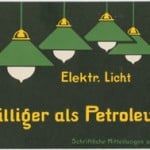
Complementing The Postcard Age will be the exhibition Art in the Street: European Posters, on view December 15, 2012, through July 21, 2013, in the Frances Vrachos Gallery and the Mary Stamas Gallery at the MFA. It will feature nearly 40 posters, many of them recent acquisitions being shown for the first time, which will be drawn from the Museum’s collection of some 2,500. The exhibition will explore the international poster mania of the 1890s, which made fine art accessible to the masses, bringing it out of the salon and into the streets and shop windows. Art in the Street will highlight virtually every major style in poster design of this era by a wide range of artists, including Henri de Toulouse-Lautrec, Pierre Bonnard, Adolphe Jean-Marie Cassandre, Jules Chéret, and Wassily Kandinsky. The exhibition is presented with generous support from The Bruce and Laura Monrad Fund for Exhibitions, and an anonymous donor.
The Museum of Fine Arts, Boston (MFA), is recognized for the quality and scope of its encyclopedic collection, which includes an estimated 450,000 objects. The Museum’s collection is made up of: Art of the Americas; Art of Europe; Contemporary Art; Art of Asia, Oceania, and Africa; Art of the Ancient World; Prints, Drawings, and Photographs; Textile and Fashion Arts; and Musical Instruments.
For more information, visit www.mfa.org or call 617-267-9300. The MFA is located on the Avenue of the Arts at 465 Huntington Avenue, Boston, MA 02115.
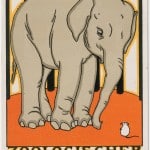
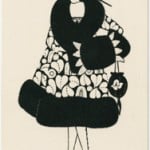
www.mfa.org/exhibitions/postcard-age/no-postage-required will be able to send
free digital postcards to family and friends by browsing through several of the mini
masterpieces from the Leonard A. Lauder Postcard Collection, selecting a card,
writing a message, then sending—no postage required!
The postcard maintains friendship. Printer and Publisher:
A. Bergeret et Cie (Nancy, France). About 1904.
Havana with Price Tour, so near and yet so foreign,
90 miles from Key West. Visit Cuba.
Conrado Massaguer (Cuban, 1889-1956).
Publisher: Geuine Curteich-Chicago C.T. Art-Colortone. About 1920.
Elephant and a mouse, from the series
Basel Zoological garden. Hedwig Keerl Thoma
(Swiss, 1886-1946). About 1922.
Water, from the series Elements. Gisbert Combaz (Belgian, 1869-1941). Publisher: Dietrich et Cie. Belgian, 1898.
Water, from the series Elements. Gisbert Combaz (Belgian, 1869-1941). Publisher: Dietrich et Cie. Belgian, 1898.
Water, from the series Elements. Gisbert Combaz (Belgian, 1869-1941). Publisher: Dietrich et Cie. Belgian, 1898.
Electric light cheaper than petroleum.
Publisher: Geschãftsstelle für Elektrizitãtsverwertung.
About 1910.
Triennale d’oltremare/S, from a series for Triennale exhibition of Italian overseas territories, 1939.
Artist: Cella. Publisher: F. Raimondi, Naples, Italy.
Number 128, from the series the twelve months.
François Laskoff (Polish, 1869-1918).
Publisher: Officine G. Ricordi & Company, Milan, Italy.
With united forces! Official card for the Red Cross Auxiliary War Office-War Welfare Center. Printer: Alb. Berger (Vienna, Austria). Vally Petter (Austrian, 20th century). About 1914.
Floral patterned coat, fom the series Blanche-noir.
Publisher: F. Morawetz, Salzburg after 1905.




Related posts: